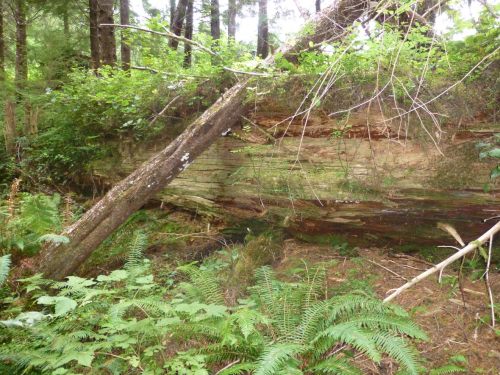
Once a tree dies it still has a lot of life in it. In fact, dead wood can provide more habitat value to many species than living wood. Wood itself is a substrate for food and cover for many species, but living trees work hard to protect themselves from organisms trying to use that wood. Pitch, bark and other mechanisms keep the tree alive. But, once the tree is dead, those woody fibers become fodder for many organisms and play key roles in forest ecosystems, including as wildlife habitat.
Standing dead trees are excellent habitats for many species (a future article). Once a tree falls over, down logs are a major player in ecosystem processes. In forests of the Pacific Northwest, because of our excellent climate for growing trees and the slow nature of decay, logs become particularly important. They help recycle nutrients into the soil, retain moisture in dry seasons, provide structure for plants to live on, create essential habitat structure in streams, and play many other roles.

Down logs also provide important and critical habitats for many wildlife species, from the smallest shrew or wren to the black bear. Fungus acts as the primary agent to break down rotting wood, and these fungi are fed upon by small arthropods (some are insects) that in turn are eaten by larger insects who are in turn eaten by small mammals (such as shrews), larger mammals (bears and raccoons) or birds foraging around the rotting log. Bears and woodpeckers will also tear logs apart while hunting for insects.
Amphibians, particularly salamanders, live in the matrix of rotting wood, eating these arthropods and hiding in narrow spaces within the decaying wood. Many salamander species absolutely require the moist environments of down logs for survival. Reptiles, such as fence lizards and rubber boas, will live in, on and under down wood.
Shrews are our tiniest mammals and use down logs. They can eat their own weight, and more, in food each day. They will starve to death if they don’t feed many times per day, and have incredibly fast metabolisms with heart rates of 1,200 beats per minute . They are ferocious predators (for their size) and eat mostly insects. They even will eat small frogs! They weigh only 2-21 grams (a penny weighs about 3 grams), are only 1-2 inches long, and are hard to tell apart by species. We have 11 species in the genus Sorex in Washington. Shrews make tiny trails along the forest floor, and are avid users of down logs. Sometimes cats will kill shrews and give us an (unfortunate) opportunity to study these incredible little carnivores that live in down logs.

Other small mammals, such as chipmunks or squirrels, will use down wood for hiding or denning cover, storing food or as lookout posts, and will spread fungal spores around the forest in their feces. Many organisms feed directly on mushrooms, and thus are themselves inoculated. The role of small mammals in the decomposition chain of forest wood is complex.
Douglas and red squirrels will cache cones in cracks of down logs, and use logs as sites for feeding on cones. Note the piles of cone scales in these favorite locations. Sometimes that tells you a cone cache is close by.

Birds will use down wood for habitat; for example, the ruffed grouse. Males of this species will select particular logs in their home range for their remarkable territorial display in which the male attracts females by ‘drumming’ the air with rapidly beating wings. In the spring, that mysterious thumping sound that we hear in the woodlands is not someone trying to start their car! It is likely a ruffed grouse standing high on his selected log, showing off for prospective mates.
Hollow logs are a rare and valuable habitat feature in forests, and should be protected where they occur. All hollow logs began as hollow trees, as the living tree protected the outer layers of wood and bark from decay, while the heart wood rotted out. Bears can use hollow logs for dens, as can smaller animals such as squirrels, bobcats or raccoons.
Larger down logs last much longer in the forest ecosystem due to slower decay rates from their sheer size. Also, some tree species last longer due to their natural resistance to decay (for example, cottonwood vs cedar). All rotting wood has a valuable function in the forest.
Historically, in dry forests, there was less down wood due to frequent fires, but the habitat roles were the same and the importance to wildlife was the same. In moist forests, down wood persists for a long time, eventually rotting into the duff layer. In moist forests, rotting wood provides “nurse” habitat for young trees such as Western hemlock.
Pieces of large down wood are “legacy” structures in forest ecosystems, meaning they persist and take a long time to form. That means they must be considered strategically over time, and protected when we enter stands for management activities. In Washington, the forest practices rules recognize the ecological importance of down wood and require retention of some down wood after a timber harvest.
Big logs are unique and valuable features in your woodlands and forests well worth keeping and enjoying.
Please contact your WSU forestry extension specialist or Washington DNR for more information or a site visit to assess your forest for down wood, and other forest features.
By Ken Bevis, Stewardship Biologist, Washington State Department of Natural Resources, ken.bevis@dnr.wa.gov
Where to get more information about down logs as habitat
- Birds of North America: Golden Field Guide, 1983
- Johnson and O’Neil. 2001. Wildlife Habitat Relations in Oregon and Washington. pp. 580-581
- Moskowitz, D. 2010. Wildlife of the Pacific Northwest; Tracking and Identifying Mammals, Birds, Reptiles, Amphibians and Invertebrates.
- National Wildlife Federation. Wildlife Information web page. 2010.

One thought on “Down Log Denizens”
Comments are closed.